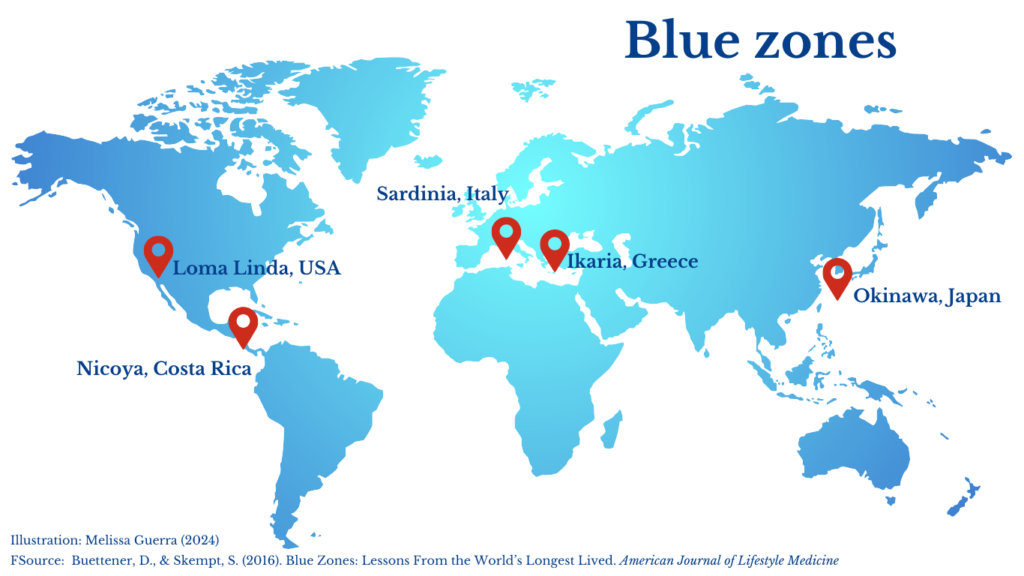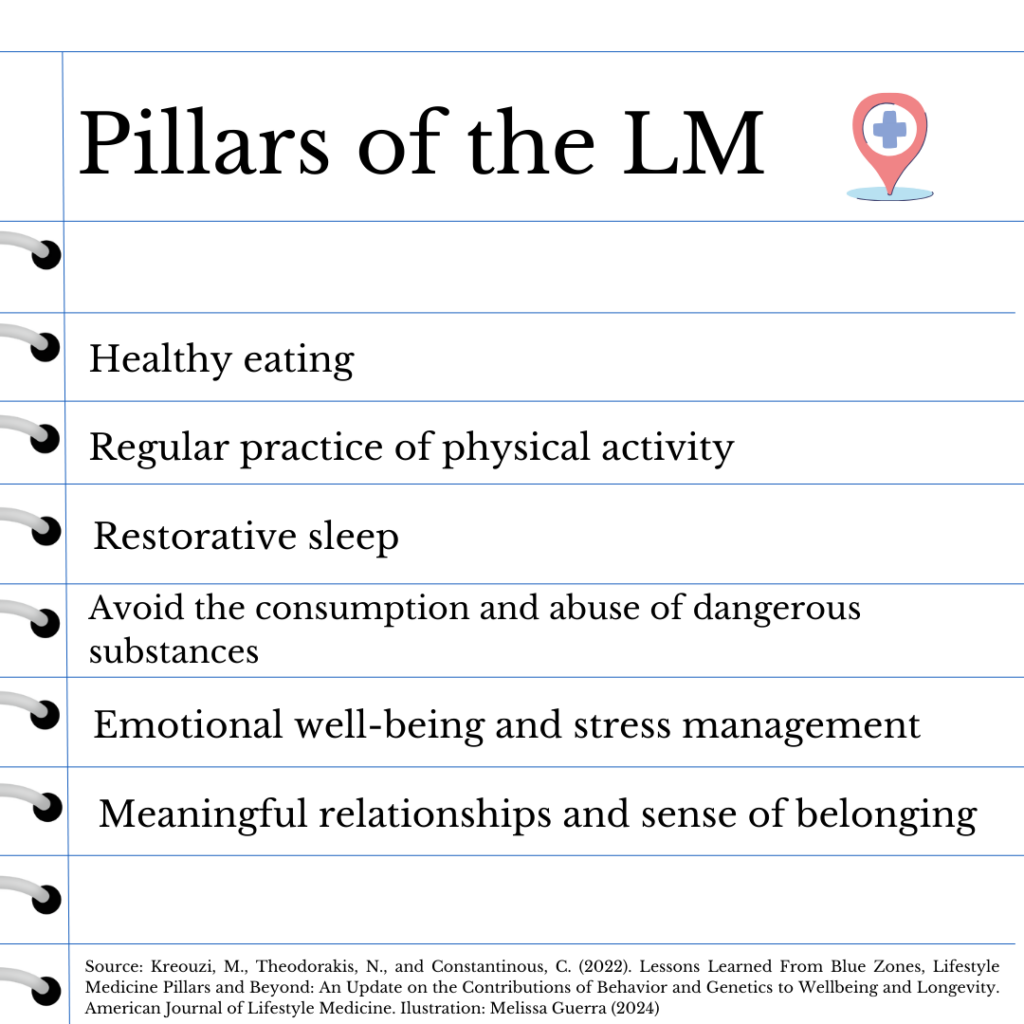Today’s world is chaotic, technological, and busy. Multitasking, long working hours, job insecurity, and inequality, among other dilemmas, preoccupy society. Problems such as chronic diseases, stress, poor diet, little or no sleep, hygiene, a sedentary lifestyle, and others are the results of a lifestyle that often consumes one’s existence.
According to the World Health Organization’s 2019 data, the average global life expectancy was 73 years: 71 for men and 76 for women. Notably, the Danish Twin Study reported that a person’s longevity is determined 20% by genes and 80% by lifestyle. For this reason, in our stressful world, it would be unreasonable to expect life expectancy to exceed 90 years, which would be a healthy life of well-being. However, some areas of the world are long-lived, healthy, and happy.
What are Blue Zones?
Five specific geographical areas of long, happy living share common characteristics. They were discovered thanks to Dan Buettner, a researcher and writer, and a National Geographic expedition, which included scientists, anthropologists, and demographers collaborating with the National Institute of Aging.
Buettner was trying to find the factors that lead to longevity. Thanks to these researchers, the “blue zones” were discovered, which had a particular characteristic: in those places, people were nonagenarians (in their 90s) and centenarians (100 and over). For validation, they were guided by various indices, such as the Centenarian Prevalence, the Centenarian Rate, and the Extreme Longevity Index.
The five blue zones currently existing are Okinawa, Japan; Sardinia, Italy; Nicoya, Costa Rica; Ikaria, Greece; and Loma Linda, USA.

What’s so special about the blue zones?
According to Buettner, these locations share nine specific characteristics (the “Power 9″), which support the living environment for longevity:
- Move naturally: People in blue zones are physically active due to their daily activities, such as harvesting and gardening, thanks to their living environments.
- Purpose: “The reason you awake every morning.” To the Japanese, this is called Ikigai.
- Stress resilience: People in blue zones have daily habits/routines to relieve stress. For example, Okinawans take a moment to remember their ancestors.
- The 80% rule: Okinawans observe a rule called Hara hachi bu, a Confucian mantra that advises people to stop eating when they feel 80% full. In addition, people in the blue zones have their last meal in the late afternoon.
- Vegan diet (plant slant): Diets based on fava beans, black beans, soybeans, and lentils are prevalent within the blue zones. Meat consumption is limited in some blue zone regions.
- Drinking wine: Wine is usually consumed moderately (except in Loma Linda, where people are Adventists who do not drink alcohol). One study states that people who drink in moderation live longer than non-drinkers.
- Sense of belonging: Most people living in the blue zones belong to some religious organization or community. Studies have shown that attending religious services regularly increases life expectancy from 4 to 14 years.
- Loved ones come first: People in blue zones prioritize their loved ones, keeping their parents and grandparents close (they care for them when the time comes). They have a life partner and invest their time and money in raising their children.
- Right tribe: Their close social circles help them maintain healthy habits.
Lifestyle Medicine and Blue Zones
Lifestyle Medicine (LM) is “the evidence-based practice of assisting individuals and families in adopting and maintaining behaviors that improve health and quality of life, such as healthy eating, regular physical activity, restful sleep, stress management, cessation of substance use, and a strong social support network.”
Similarly, Izcue et al. (2021) reported that lifestyle medicine has been shown “to be effective in the prevention, management and sometimes reversal of the pathologies that carry the highest global morbidity and mortality, such as arterial hypertension, Type 2 Diabetes Mellitus, coronary heart disease, and obesity. An estimated 80% of chronic non-communicable diseases could be prevented by leading a healthier lifestyle.”
The six pillars of LM
The modern focus of Lifestyle Medicine (LM) considers six fundamental pillars for the prevention and treatment of chronic non-communicable diseases (CND):

A 2022 American Journal of Lifestyle Medicine study compared Buettner’s Power 9 principles to the six pillars of LM and research focusing on the relationship of behavioral factors, longevity, and genetics. The study aimed to understand how these aspects affect molecular pathways and their consequences on well-being and longevity.
It concluded that the key fundamentals of the Blue Zones (The Power 9) and the principles of LM positively correlate with well-being and longevity. In addition, it concluded that behavior and genetics influence some of the human body’s systems, including its cardiovascular, immune, endocrine, and gastrointestinal systems.
Aging Successfully
Successful aging is a multidimensional concept within the biopsychosocial model. This approach studies health and disease, considering biological, psychological, and social aspects. Notably, this approach prioritizes three fundamental elements of successful aging:
- Maintaining physical and mental performance.
- Absence of Illness and Disabilities.
- Active and continuous social life.
What can this teach us about human flourishing?
The nine specific characteristics of the Blue Zones (The Power 9) are similar to the domains of human flourishing because they encompass many spheres that involve a person’s integral well-being. Thus, even if you do not follow a vegan or Mediterranean diet, the blue zone dimensions can guide you to flourishing.
Considering VanWeeler’s most current human flourishing domains (happiness and satisfaction in life, physical and mental health, meaning and purpose, character and virtue, and close relationships) shows that the inhabitants of the Blue Zones enjoy well-being thanks to their lifestyles, which inevitably supports their personal flourishing.
For example, having a life purpose increases life expectancy, decreases the likelihood of a heart attack by 19%, and makes people 2.4 times less likely to develop Alzheimer’s. On the other hand, close interpersonal relationships help the sense of belonging, which can improve mental health and well-being. A study on social relations and mortality risk demonstrated that people with strong social relationships have 50% less risk of dying than those with few or insufficient interpersonal relationships.
Much can be learned from the blue zone principles for our well-being; considering these factors can help us reach our full potential, which is one of the premises of human flourishing, which involves a person’s mental, physical, and social well-being.
So, while the blue zone approach emphasizes longevity, some of its vital lessons can be replicated to increase our well-being, guiding and motivating us to begin good habits that help us achieve our flourishing.
Reference: Izcue, J., Cordero, M., Plaza, M., Correa, P., and Hidalgo, A. (2021). ¿Qué es la Medicina del Estilo de Vida y por qué la necesitamos? (What is Lifestyle Medicine, and Why Do We Need It?) Revista Médica Clínica Las Condes, 32(4).
Translation by Daniel Wetta
This article from Observatory of the Institute for the Future of Education may be shared under the terms of the license CC BY-NC-SA 4.0 
)
)


)